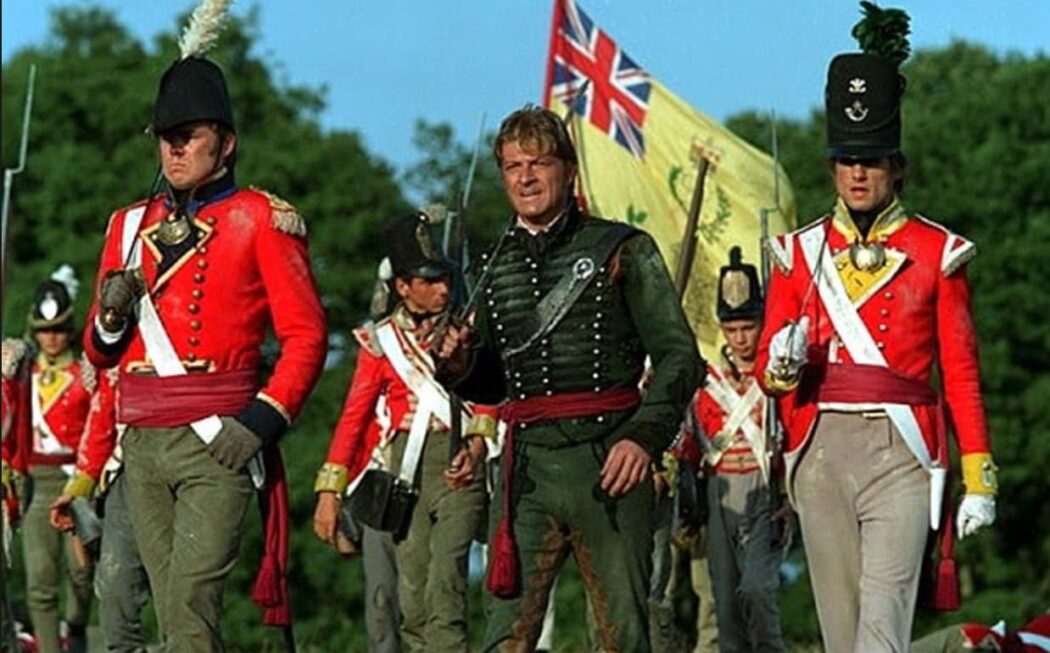Historical reconstructions are not merely entertainment or a way to visually present events of the past. They are an art form, requiring knowledge, attention to detail, and the ability to tell a story that comes alive before the viewer’s eyes. The Battle of Waterloo, one of the most iconic in history, has been the subject of numerous reconstructions, but few have left such a cultural imprint as the finale of the Sharpe series starring Sean Bean.
The Real Battle: Why Waterloo?

The Battle of Waterloo, fought on 18 June 1815, marked the end of the Napoleonic Wars. It was here that two mighty armies clashed: Napoleon’s Grande Armée and the allied forces led by the Duke of Wellington and Prussian Field Marshal Blücher. This battle symbolised not only military confrontation but also the end of an era dominated by Napoleon, whose ambitions reshaped Europe’s map.
The battle unfolded on the plains of Belgium, with key moments including the French cavalry’s assault, the allies’ defence of strategic farmhouses like La Haye Sainte and Hougoumont, and the decisive intervention of the Prussian troops. Its dramatic scale, tactical complexity, and intertwined human destinies have captivated artists, writers, and filmmakers for centuries.
Sharpe: A Hero Amidst History

The Sharpe series became a cult classic by combining historical accuracy, gripping drama, and the charisma of Sean Bean. The series finale, Sharpe’s Waterloo, takes the viewer straight to the heart of the battle. But how accurately does it portray the spirit of the era and the realities of the conflict?
Richard Sharpe, the fictional hero created by author Bernard Cornwell, serves as a guide through the events of the Napoleonic era. Sharpe is a man who rose from the ranks to become an officer through sheer courage and intelligence. His perspective on war is deeply personal, making even grand-scale events like Waterloo more emotional and relatable.
Recreating the Battle: Truth and Artistic License
The creators of Sharpe’s Waterloo faced a challenging task: depicting a historical event while remaining true to the facts yet preserving the dramatic arc. Some scenes were recreated with incredible accuracy, while others were the product of artistic imagination.
One of the key episodes was the fight for the Hougoumont farmhouse. In the film, this part of the battle is shown as a pivotal moment where Sharpe finds himself at the centre of the action. Historically, Hougoumont symbolised the heroism of British forces who held the farmhouse against relentless French attacks. While Sharpe’s involvement in this clash is fictional, the scene’s dynamic and emotional intensity make it one of the film’s most memorable moments.
Other details, such as the soldiers’ uniforms, the formation structures, and the general chaos of battle, are depicted with remarkable accuracy. The work with extras is particularly impressive: the filmmakers convey the crowd and chaos of the event convincingly. Although budget constraints prevented massive scenes with thousands of extras, skillful editing and thoughtful camera angles ensure the battle feels appropriately grand.
Heroism and Human Drama
Sharpe’s Waterloo masterfully blends elements of a war epic with personal drama. Sean Bean brings vulnerability and humanity to his character, which contrasts with the epic scale of the events. The viewer sees war not only as a clash of armies but also as a trial for every individual involved.
One particularly compelling moment is when Sharpe must choose between following orders and saving his comrades. Such episodes, though not always historically grounded, help capture the spirit of an era where personal qualities of officers often determined the outcomes of battles.
Historical Reconstruction Through Art
Historical films and series rarely avoid simplifications and inaccuracies, as their primary goal is not to teach history but to evoke emotion. However, Sharpe’s Waterloo strikes a fine balance between truth and artistic invention.
Compared to the real battle, the film captures many accurate details. For example, it shows the complex terrain that played a critical role in the conflict. The British forces used elevated positions for defence, a decisive factor in their success. The film also highlights key moments like the infantry squares resisting French cavalry — a tactical manoeuvre that vividly demonstrates the power of disciplined troops.
Still, it’s essential to remember that the film focuses on Sharpe and his personal story, which sometimes distorts the historical reality. For instance, Sharpe’s involvement in key episodes of the battle might seem implausible given the scale of the events and the number of people involved. Nonetheless, these additions bring drama and make the film more engaging.
The Legacy of Waterloo in Culture

The Battle of Waterloo continues to inspire artists and audiences alike. It has become a symbol of courage, strategy, and resilience. Through films like Sharpe’s Waterloo, viewers not only learn about past events but also experience them emotionally.
Historical reconstructions, whether large-scale battle scenes or personal stories, play a crucial role in popularising history. They bring events to life, making them accessible to modern audiences. Sharpe’s Waterloo is an excellent example of how art can bridge the past and present, prompting reflection on heroism, the cost of war, and the significance of personal bravery.
Conclusion
Sharpe’s Waterloo is not only an entertaining spectacle but also a respectful homage to history. The creators succeeded in recreating the atmosphere of one of the greatest battles while keeping the focus on the human side of war. Sharpe may be a fictional character, but his story reminds us of the real people whose courage and loyalty shaped history.



